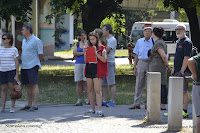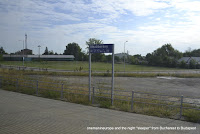S.M.S Leitha - guarding the Danube
I was fortunate to turn left and exit the building on the riverside rather than returning to the Parliament Square. As you saw in my last post I looked right and left taking in the views but a boat opposite intrigued me. I decided to cross the road and take a couple of photos of this unusual structure. A girl I crossed with carried on down the gangway as I walked to each end to photograph the structure. A group of girls lounging on deckchairs implied that this was a bar or nightclub of sorts there being no visible signage at my level.
 I decided to venture down and enquire as this was, indeed, an unusual boat. I was very pleased that I did. This discovery ended a topping day! The boat is, in fact, the only remaining Monitor class warship, the original river "Monitor" S.M.S Leitha, her sister ship, the Maros, did not survive. The vessel has been fully restored and is now a museum-ship permanently moored in front of the Hungarian Parliament building. A fitting location indeed as it would full fill their bidding. Construction began in 1870, launch one year later primarily to push the empire east down the Danube into the Balkans where it first saw action in 1878. Battles were engaged on the Sava river. A very shallow draft of 1.5 metres was required as the rivers in the area were, and are, exceptionally low. Incidentally the first "Monitor" was built during the American Civil War, the type lasted until as late as 1965.
I decided to venture down and enquire as this was, indeed, an unusual boat. I was very pleased that I did. This discovery ended a topping day! The boat is, in fact, the only remaining Monitor class warship, the original river "Monitor" S.M.S Leitha, her sister ship, the Maros, did not survive. The vessel has been fully restored and is now a museum-ship permanently moored in front of the Hungarian Parliament building. A fitting location indeed as it would full fill their bidding. Construction began in 1870, launch one year later primarily to push the empire east down the Danube into the Balkans where it first saw action in 1878. Battles were engaged on the Sava river. A very shallow draft of 1.5 metres was required as the rivers in the area were, and are, exceptionally low. Incidentally the first "Monitor" was built during the American Civil War, the type lasted until as late as 1965.
The upper deck armament of two four barrel Nordenfelt machine guns behind the Helmsman's station are dwarfed by two huge 15cm (6") breach loading Wahrendorf guns housed in the rotating gun turret. A smaller turret atop houses a second enclosed helmsman's station. The whole structure is turned from below by four crew members on each of two crank handles. My crew member and guide who had preceded me down the gangplank can be seen between the barrels ringing the 1st bell of the "Dog" watch.
A crew of 50 operated the ship and down below we see the living and working conditions and the disparity between officers and men. No space is wasted and there is little room to stand tall. An engine room complete with two railway engines, for that is what drives this beast, stoked by coal from hoppers left and right (port and starboard I suppose). An engineering officer looks on, Now surrounded by scale models of the ship, a ship in a bottle or a carving would have passed the off duty time when the ship was live. I banged my hard hat on something as we ventured forward!
Passing store rooms and larder we find the officers quarters, somewhat more comfortable, especially the captains cabin. As this is a river "cruise" life would be more stable, apart from battle, than that of the high seas. This is reflected in the home like contents of the cabin alongside the functional office desk and chair. 2nd and 3rd officers had to bunk but they all had wooden wardrobes and a table. The ratings meanwhile slept in hammocks and stored their possessions in kit-bags pilled in the cavities provided.
Back we go to the turret emerging from the separate powder and shell magazines. It almost looks like a warship of Nelson's day. The scene is set to do battle. A display board on the wall shows the make-up of shell cordite placed in the breach. Above the helmsman will steer and the crew below will follow on their crank handles. A hot noisy business in a floating tin can, which emphasises the most important room in the house or the ship's "head" to be precise!
A truly magnificent end to a remarkable day. I hope that you enjoyed the photos of the Parliament in my previous post and will have a look around the S.M.S Leitha photo album with me. Mid your head though, no virtual hard hats here! Tomorrow a trip on the Danube and an evening concert to round off my stay in Budapest.
More information about the ship and its history can be found here on Wikipedia: SMS Leitha.
 I decided to venture down and enquire as this was, indeed, an unusual boat. I was very pleased that I did. This discovery ended a topping day! The boat is, in fact, the only remaining Monitor class warship, the original river "Monitor" S.M.S Leitha, her sister ship, the Maros, did not survive. The vessel has been fully restored and is now a museum-ship permanently moored in front of the Hungarian Parliament building. A fitting location indeed as it would full fill their bidding. Construction began in 1870, launch one year later primarily to push the empire east down the Danube into the Balkans where it first saw action in 1878. Battles were engaged on the Sava river. A very shallow draft of 1.5 metres was required as the rivers in the area were, and are, exceptionally low. Incidentally the first "Monitor" was built during the American Civil War, the type lasted until as late as 1965.
I decided to venture down and enquire as this was, indeed, an unusual boat. I was very pleased that I did. This discovery ended a topping day! The boat is, in fact, the only remaining Monitor class warship, the original river "Monitor" S.M.S Leitha, her sister ship, the Maros, did not survive. The vessel has been fully restored and is now a museum-ship permanently moored in front of the Hungarian Parliament building. A fitting location indeed as it would full fill their bidding. Construction began in 1870, launch one year later primarily to push the empire east down the Danube into the Balkans where it first saw action in 1878. Battles were engaged on the Sava river. A very shallow draft of 1.5 metres was required as the rivers in the area were, and are, exceptionally low. Incidentally the first "Monitor" was built during the American Civil War, the type lasted until as late as 1965.The upper deck armament of two four barrel Nordenfelt machine guns behind the Helmsman's station are dwarfed by two huge 15cm (6") breach loading Wahrendorf guns housed in the rotating gun turret. A smaller turret atop houses a second enclosed helmsman's station. The whole structure is turned from below by four crew members on each of two crank handles. My crew member and guide who had preceded me down the gangplank can be seen between the barrels ringing the 1st bell of the "Dog" watch.
Passing store rooms and larder we find the officers quarters, somewhat more comfortable, especially the captains cabin. As this is a river "cruise" life would be more stable, apart from battle, than that of the high seas. This is reflected in the home like contents of the cabin alongside the functional office desk and chair. 2nd and 3rd officers had to bunk but they all had wooden wardrobes and a table. The ratings meanwhile slept in hammocks and stored their possessions in kit-bags pilled in the cavities provided.
Back we go to the turret emerging from the separate powder and shell magazines. It almost looks like a warship of Nelson's day. The scene is set to do battle. A display board on the wall shows the make-up of shell cordite placed in the breach. Above the helmsman will steer and the crew below will follow on their crank handles. A hot noisy business in a floating tin can, which emphasises the most important room in the house or the ship's "head" to be precise!
A truly magnificent end to a remarkable day. I hope that you enjoyed the photos of the Parliament in my previous post and will have a look around the S.M.S Leitha photo album with me. Mid your head though, no virtual hard hats here! Tomorrow a trip on the Danube and an evening concert to round off my stay in Budapest.
More information about the ship and its history can be found here on Wikipedia: SMS Leitha.








Comments
Post a Comment